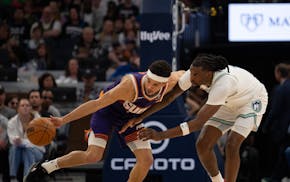In his 1959 novel "Goldfinger," Ian Fleming draws upon the peculiarities of Royal St George's as a faintly disguised setting for a high-stakes golf match between James Bond and the diabolical Auric Goldfinger.
British Open entrants, though, might be just as apt to guess the scene was part of "Moonraker."
"Lunar" is a popular word to describe the bumps and pockmarks that spatter the fairways on the southeast England linksland that will be the site of the British Open starting Thursday.
Others might prefer the term "loony."
"It's very much humps and bumps," British golfer Justin Rose said, "and you're very much at the mercy of the course in the terms of the kicks you can get."
Perhaps that's why it's not a course well-loved by the players.
"I think probably from a history standpoint and the romantic part of playing the Open Championship, it's one of the least romantic," ESPN analyst Andy North said. "There is not the love affair there that some of the other places have."
Not with crosswinds off the North Sea that make the good shots even more uncertain. Or with hazards bearing such colorful names as the Dragon, Hades, the Suez Canal, Nancy's Parlour and Duncan's Hollow.
That sounds more like what you'd find in a high-tension thriller. Or a spy novel.
Consider J.H. Taylor's result when the Open first left Scotland in 1894 for a whirl at the new links in Sandwich. Part of Britain's "Great Triumverate" with Harry Vardon and James Braid, Taylor shot four rounds in the 80s and won by five.
When the Open returned five years later, 73 players in the 101-man field withdrew after the first round. At the 1922 edition, George Duncan blew a chance to force a playoff with Walter Hagen when he caught the uneven ground on a short greenside chip at No.18, making bogey.
Only one man broke par on the fast and fiery fairways that greeted golfers at the Open's last visit in 2003 -- Ben Curtis, the PGA Tour rookie playing in his first major. Thomas Bjorn lost his grip on the Claret Jug when he needed three shots to escape a greenside bunker at No.16.
"That stuff happens in a heartbeat," North said.
Added ESPN's Curtis Strange, a two-time U.S. Open champion: "Mentally, you have to take into account that what you thought was going to happen might not happen."
Peter Dawson, the chief executive of the Royal & Ancient Golf Club, is not promising that St George's will be any easier than it was in 2003, but he said the course will be fairer.
"There was no rain here between February and May, virtually not a drop," he said Sunday of 2003. "The rain has come back to average level, and the course has greened up -- we are pleased with it. The player reaction has been very positive."
Truth be told, goofy bounces are part of the charm of links golf. And, as 1996 Open champion Tom Lehman was quick to note, part of the strategic planning.
"If you go look around [Royal St George's], every hole has a flat area to land your shot," he said.
Lehman's first British Open came at Sandwich in 1993, when Greg Norman won with a closing 64. As he got to know the course, Lehman saw that the smoothest landing areas were a club or two short of the bumpy sections.
"If you land your ball in that short area," the Minnesota native said, "you can run it up into the bumps so you can keep yourself on the fairway. But guys don't want to give up the length -- you've got to hit a 3-wood to do that, or even a 1-iron.
"Guys don't want to give up the length a driver gives you, but I'll take the fairway versus the foot-high rough every time."
